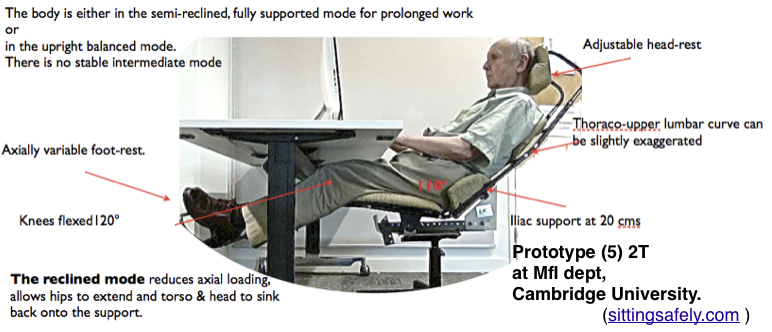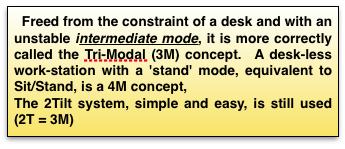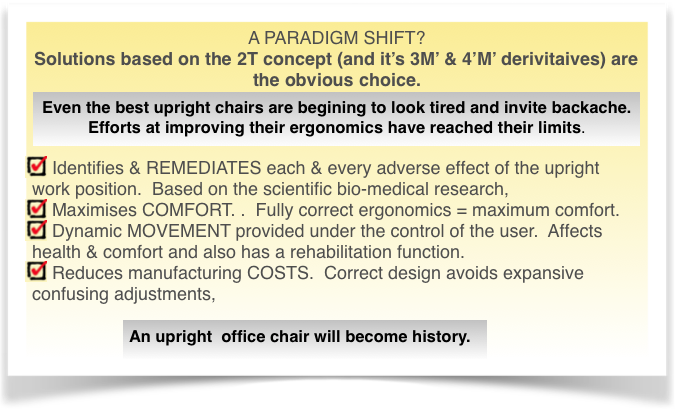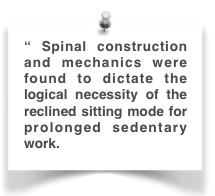A full ergonomic solution. An optimal system that effectively gives a full remediation of all the adverse effects of upright sitting that have been enumerated. It is the optimised default against which the ergonomics of any chair can be assessed for establishing its ergonomic efficiency. An essential tool for chair design.
Listed here are the identified (☛ see Science→ ) adverse bio-mechanical (ergonomics) factors of Upright Sitting requiring a full remediation of Ergonomics to ensure a safe sitting position :-
- ☒Raised intradiscal pressure (IDP) from spinal axial loading in the upright state. ☛Loading→. A major factor in IV Disc prolapse. ☛Inter Vertebral Disc (IVD)→
- ☒The retroversion (backward tilt or to an an anatomist a ‘forward tilt’) of the pelvis, which occurs on sitting upright, reduces or reverses the protective disc wedge angle. ☛ BIOMECHANICS that determine safe sitting→ .Reduction of the IV Disc wedge angle (☛Sato 1999).
- ☒In addition a flexed lumbar spinal position leads to permanent stretching of the posterior elements with instability and ☛CDT→.
- ☒A seat parallel to the floor, giving a hip angle of 90°, allowing the hip extensor muscles (hamstring & glutei) to rotate the pelvis so as to flatten the lumbar lordosis. Ideal angle of hip extension is 130°
(☛Smith 2006). - ☒A prolonged static constrained posture. ☛ EXERCISE & movement →
- ☒Sleeplessness. (For an account see ☛Metrojet→ )
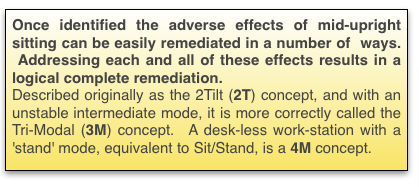
The Two Tilt, 2T, Principles
- A Reclined stable mode at end of range for prolonged work. ☛The 2T reclined mode→
- An Upright stable Mode (hence the 2T) for certain short activities and quitting the chair ☛2T Upright modes→
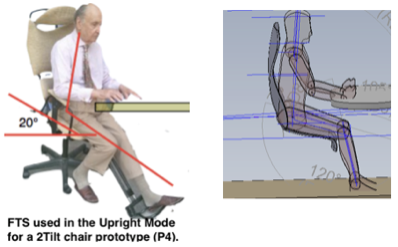
- Transitional Mode. The mid ranges should be unstable and easily negotiated.
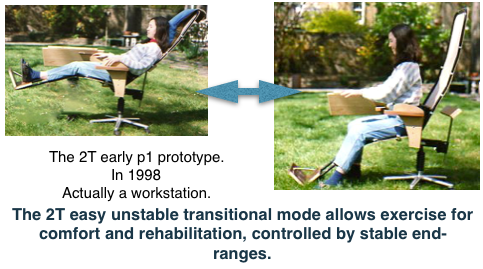
- This may seem counter-intuitive. Why shouldn’t the user be able to sit easily in any position that seems comfortable? It worries chair designers dreadfully although they may not be bothered by the ‘dynamic seating’ concept.. It is also a mode with actual benefits and allows the concept to be renamed Tri-Modal concept (3M).
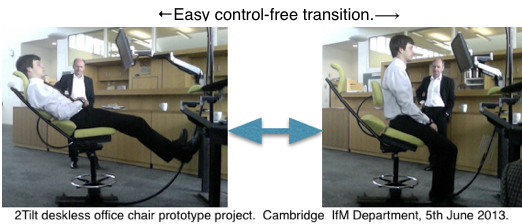
- 2T Principle 3.Requirement 8. Mid ranges should be unstable and easily negotiated. It is necessary to be able Screen Shot 2015-10-07 at 13.43.22to switch rapidly and easily from a reclined to the upright mode2T mid range.
- 4. .The addition of a standing mode creates a Quadri-Mode (4M) chair station with a Sit/Stand capability..☛ Sit Stand & stools
Versatility
Three versions can be derived using the 2T concept shown above indicating a large blank page for any designer obeying the principles for optimal ergonomics and comfort.
- The original 2T (3M) model which is set at a desk and can form a hub. See 2T Chair Desk interface →
- The ‘deskless’ or workstation model. See OFFICE WORK-STATIONS →
- The Sit/Stand model with a standing component (4M). See Sit Stand & stools →
REQUIREMENTS for the 2Tilt concept.
To achieve an efficient working 2T (3M) chair a number of requirements are essential to achieve a full remediation of Ergonomics.
Principle 1
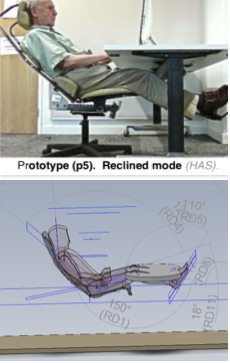 Reclined mode. The optimum for prolonged work
Reclined mode. The optimum for prolonged work
Prolonged sitting tasks should be performed in the reclined position with the backrest at 40-45° from the horizontal using a normal desk. This can be reduced with a desk-less version (3M). pMRI studies have confirmed that the risk of posterior disc displacement is avoided by supine or semi-supine positions.(Smith,2006). In the reclined mode some requirements are necessary to ensure optimal support and must include the following :-
- Requirement 1 Support is given to the entire length of the body, from head to feet with a back support correctly configured to spinal morphology, with iliac support at correct level and shape.
- Requirement 2. Even with the reduced axial loading the lumbar lordosis should be maintained and this is best effected by some pelvic (not lumbar) support. This should only be sufficient to avoid lumbar flattening, and should avoid excessive lordosis.
- Requirement 3. Some extra curve (kyphosis) of the thoracic spine, over that which pertains on standing, is allowed because it is fully supported and is a stable area and not liable to mechanical breakdown. It extends, with the upper lumbar joints, over 14 segments and the extra flexion at any single joint is minimal.
- Requirement 4. A correctly placed head/neck-rest is required so that the occupant has no need to move the neck to establish the task-related visual field.
- Requirement 5. It is necessary to have support for the legs and feet. Compression of the calf muscles should be avoided. A spring exercise system is an advantage. The floor is allowed as a foot-rest if the knees can remain extended.
- Requirement 6. Variability at head and feet only. These are the most variable parts of the human body, in the reclined mode. Adjustments avoided elsewhere. ☛Adjustments→.
- A reclined 40-45° position is advised for a stand-alone 2T chair. Greater angle, nearer fully supine, is possible with a deskless work station (3M) and ☛4M OFFICE WORK-STATION→.
- For more detail see ☛The 2T reclined mode→
Principle 2. (Hence the 2T concept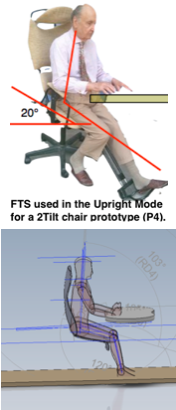
A 2Tilt Upright Mode is subsidiary but required for certain short activities and quitting the chair and is the default mode when the chair is unoccupied. ☛2T Upright modes→ ☛UPRIGHT MODE & TRANSITION for the 2Tilt concept →.
• Requirement 7. Although intended for short term use, maintaining the wedge angle of the lower two lumbar joints, in the upright modes necessary in case the user prefers it for long term use, This can be achieved by a ☛forward tilted seat (FTS) or by correct use of ☛ iliac support. The latter cause additional design problems in this case and so is not recommended for an original design but may be convenient for modification of an existing model.
Principle 3. An unstable transitional mode.
• Requirement 8.Mid ranges should be unstable and easily negotiated. It is necessary to be able 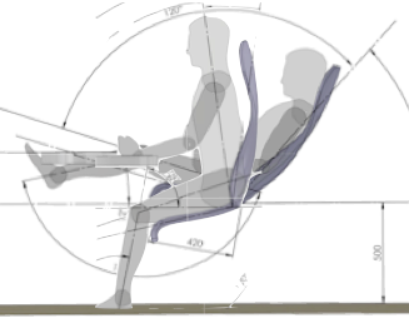 to switch rapidly and easily from a reclined to the upright mode.
to switch rapidly and easily from a reclined to the upright mode.
- This is mainly for convenience but the switch also results in a change of pressure on the disc and this has the added advantage of providing a pumping action which aids disc nutrition. ☛Disc Nutrition & Spinal Movement.→
- No adjustment is allowed to maintain an intermediate position
- These reproduce the conventional adverse sitting posture and should be avoided. (☛Mandal→)
- Their instability can be used for short periods as a form of exercise ( ☛dynamic seating→),
- Particularly for rehabilitation of the Multifidus (☛ muscles→) following an internal derangement at the low lumbar joints. For a fuller account. see ☛Unstable intermediate mode →
Requirement 9. Adjustments should be avoided as far as possible.
This flies in the face of chair designers who are searching for the Holy Grail of infinite adjustability an entirely misplaced endeavour and merely another example of ‘familiarity bias’.ADJUSTMENTS?→
(Requirement 10. Avoid Familiarity bias )
This leads on to the QuadriModal, 4M work-station.
- Reduced office footprint.
- 2T requirements easier to achieve.
- Easy to move about & around.
- Allows short periods of sleep ( ☛SLEEP & productivity and MetroNaps→)
- 2T in the office and ☛4M work-station→
For Remediations (partial) which are in use …
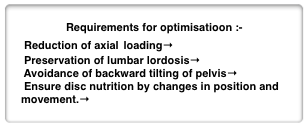 A number of solutions are in use which address some of the above adverse factors. These partial solutions are for mid-upright sitting in chairs that have been well designed and engineered. However they are not a solution to fully reduce the incidence of backache (LBP). This would require a new technical fix that addresses all identified adverse bio-mechanics effects of prolonged upright sitting
A number of solutions are in use which address some of the above adverse factors. These partial solutions are for mid-upright sitting in chairs that have been well designed and engineered. However they are not a solution to fully reduce the incidence of backache (LBP). This would require a new technical fix that addresses all identified adverse bio-mechanics effects of prolonged upright sitting
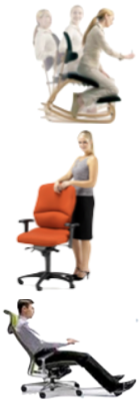 Forward Tilted seat (FTS) ☛ The FTS→
Forward Tilted seat (FTS) ☛ The FTS→- Back support of some sort. ☛ Lumbar v Iliac support→
- ‘Ischial off-load‘ A third system, combines these two. by use of a convex seat. This combines both a FTS and allows, at the back half, pelvic support. ☛Ischial off-load→
- The ‘Supine reclined mode’ is to some extent a full solution except lacking the requirements of the 2M concept.
ALTERNATIVE SYSTEMS
- Sit/Stand. The importance of keeping staff exercised is increasingly recognised. The negative consequences of constrained sitting has been described by a number of authorities (Adams and Hutton, 1983; Duncan and Ferguson, 1974; Edlund, There are advantages in keeping staff moving around and inter-reacting in certain types of office. Note that a sit/stand system can always incorporated into a 3M work chair station→ . For more detail See ☛Sit/Stand→
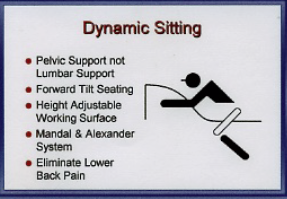 Dynamic seating. Spinal movement aids muscle proprioception and IV Disc nutrition which has a physiological advantages over constrained seating and also may have a comforting effect if under the control of the user. ☛→ EXERCISE & movement Also ☛ Disc Nutrition & Spinal Movement.
Dynamic seating. Spinal movement aids muscle proprioception and IV Disc nutrition which has a physiological advantages over constrained seating and also may have a comforting effect if under the control of the user. ☛→ EXERCISE & movement Also ☛ Disc Nutrition & Spinal Movement.


